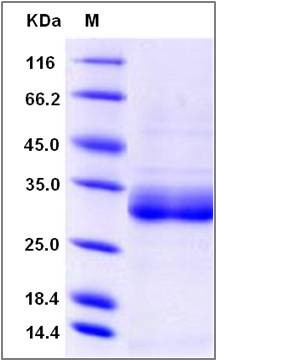Human GPX7 / Glutathione Peroxidase 7 Protein (Fc Tag)
CL683,GPx-7,GPX6,GSHPx-7,NPGPx
- 100ug (NPP3907) Please inquiry
| Catalog Number | P12651-H02H |
|---|---|
| Organism Species | Human |
| Host | Human Cells |
| Synonyms | CL683,GPx-7,GPX6,GSHPx-7,NPGPx |
| Molecular Weight | The recombinant human GPX7/Fc is a disulfide-linked homodimer. The reduced monomer comprises 408 amino acids and has a predicted molecular mass of 46.1 kDa. The apparent molecular mass of the protein is approximately kDa in SDS-PAGE under reducing conditions. |
| predicted N | Gln 20 |
| SDS-PAGE |  |
| Purity | > 95 % as determined by SDS-PAGE |
| Protein Construction | A DNA sequence encoding the human GPX7 (NP_056511.2) (Met1-Leu187) was expressed, fused with the Fc region of human IgG1 at the C-terminus. |
| Bio-activity | |
| Research Area | Signaling |Signal Transduction |Metabolism |Pathways and Processes |Redox metabolism |Oxidative stress | |
| Formulation | Lyophilized from sterile PBS, pH 7.4 1. Normally 5 % - 8 % trehalose and mannitol are added as protectants before lyophilization. Specific concentrations are included in the hardcopy of COA. |
| Background | GPX7 gene contains 3 distinct gt-ag introns. Transcription produces 4 different mRNAs, 3 alternatively spliced variants and 1 unspliced form. There are 5 validated alternative polyadenylation sites. The mRNAs appear to differ by overlapping exons with different boundaries. GPX7 is an enzyme. It has molecular functions (glutathione peroxidase activity, oxidoreductase activity) and to localize in various compartments (extracellular space, extracellular region). GPX7 gene has been proposed to participate in pathways (Arachidonic acid metabolism, Glutathione metabolism) and processes (oxidation reduction, response to oxidative stress). GPX7 modulates the bone turnover after ovariectomy in rats, it does not compensate for the action of estrogen after ovariectomy in rats. It has been shown that three mAbs (GPX7, GPX22 and GPZ35) inhibit IL-6-mediated biological responses such as Ig production in a human B cell line and proliferative responses of a human Lennert's lymphoma-derived T cell line, a human myeloma cell line, and a mouse pro-B cell line-derived transfectant expressing human gp130. |
| Reference |
